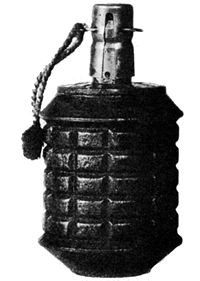- Type 97 grenade
-
Type 97 Hand Grenade 
A Japanese Type 97 grenade, with the safety fork still in place.Type Fragmentation hand grenade Place of origin  Empire of Japan
Empire of JapanService history In service 1937-1945 Used by  Imperial Japanese Army
Imperial Japanese Army
 Imperial Japanese Navy
Imperial Japanese NavyWars Second Sino-Japanese War
Soviet-Japanese Border Wars
World War IIProduction history Designed 1936 Specifications Weight 0.45 kg (16 oz) Length 98mm (5⅞ in) Filling TNT Filling weight 2.2 ounces (65 grams) Detonation
mechanismPyrotechnic delay 4 to 5 seconds The Type 97 Hand Grenade (九七式手榴弾 Kyūnana-shiki Teryūdan) was the standard fragmentation hand grenade of the Imperial Japanese Army and Imperial Japanese Navy SNLF during the Second Sino-Japanese War and World War II. [1]
Contents
History and development
The Type 97 was developed from the earlier Type 91 Grenade which could also be used as a fragmentation hand grenade, but was predominately used as munitions for the Type 10, and Type 89 grenade launchers. For this reason, it had less explosive power and a relatively longer delay time than a dedicated manual hand grenade. To address these issues, the Army Technical Bureau developed a new design in 1937.
Design
The Type 97 had the same principles as most of fragmentation grenades of the period: a grooved 'pineapple-shaped' segmented body which dispersed sharp pieces of shrapnel when it exploded. Operation was accomplished by first screwing down the firing pin, so that it protruded from the base of the striker. Then the safety pin was removed by pulling the cord to which it was attached; the protective cap which covered the striker was removed. A sharp blow against a hard surface, such as a rock or combat helmet would overcome a creep spring and crush a thin brass cap, allowing the pin to hit the primer and initiate the delay sequence before throwing at the target.[2] However, in comparison with Allied hand grenades of the period, the explosive force of the Type 97 was weaker, and the due to lack of an automatic ignition mechanism, the grenade in practice was found to be unreliable and even dangerous to use because of its inaccurate fuse.[3]
Physically, the Type 97 was almost indistinguishable from the Type 91, except that it had no attachment on the base for a propellant canister. Paper labels with ink-stamped fill dates warned of the shorter 4-5 second delay.[4]
Combat record
The Type 97 hand grenade was issued as standard equipment to Japanese infantrymen in the Second Sino-Japanese War and throughout the various campaigns of World War II. [5]
See also
References
- US Department of War (1994 reprint). Handbook on Japanese Military Forces, TM-E 30-480 (1945). Louisiana State University Press. ISBN 0807120138.
- Rottman, Gordon L. (2005). Japanese Infantryman 1937-1945. Osprey Publishing. ISBN 1841768189.
- Departments of the Army and the Air Force (1953). Japanese Explosive Ordnance, TM 9-1985-4. ASIN B000H7NCDS.
External links
- Image of a Type 97 grenade
- Details of internal construction
- Taki’s Imperial Japanese Army page
- US Technical Manual E 30-480
Notes
Japanese Infantry Weapons of World War IIHistory Firearms of JapanSwords Bayonets Side Arms Rifles / Carbines Type 30 · Type 38 · Type 38 Carbine · Type 44 Carbine · Type 97 sniper rifle · Type 99 · Type 99 sniper rifle · TERA rifle · Type 4 Automatic Rifle · Type ISubmachine Guns Light Machine Guns Heavy Machine Guns Grenades Support Weapons Type 93 Flamethrower · Type 100 Flamethrower · Type 10 Grenade Discharger · Type 89 Grenade Discharger · Type 100 Grenade Discharger · Type 2 Rifle Grenade Launcher · Type 97 20mm AT Rifle · Type 4 70mm AT Rocket LauncherCartridges 9mm Japanese · 8×22mm Nambu · 7×20mm Nambu · 6.5×50mm Arisaka · 7.7×58mm Arisaka · 7.7×58mmSR Arisaka Semi-RimmedCategories:- World War II Japanese infantry weapons
- World War II grenades of Japan
- Fragmentation grenades
Wikimedia Foundation. 2010.
